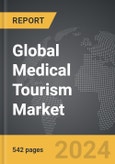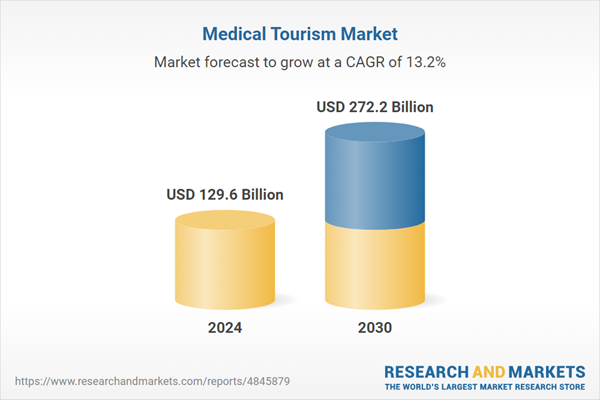The global market for Medical Tourism was valued at US$129.6 Billion in 2024 and is projected to reach US$272.2 Billion by 2030, growing at a CAGR of 13.2% from 2024 to 2030. This comprehensive report provides an in-depth analysis of market trends, drivers, and forecasts, helping you make informed business decisions. The report includes the most recent global tariff developments and what they mean for your business.
Technological advancements and improvements in global healthcare standards have significantly contributed to the rise of medical tourism. Enhanced medical equipment, innovative surgical techniques, and improved patient care protocols have boosted the reputation of healthcare facilities in medical tourism hotspots. The integration of telemedicine and digital health records has further facilitated pre-treatment consultations and follow-up care, allowing for seamless communication between patients and healthcare providers across borders. Further, many medical tourism destinations are accredited by international healthcare organizations, ensuring that the facilities meet rigorous quality and safety standards. This assurance of quality, combined with the allure of receiving treatment while exploring new cultures and locations, has fueled the growth of the medical tourism industry.
The growth in the medical tourism market is driven by several factors. Rising healthcare costs in developed countries have pushed patients to seek more affordable options abroad, where they can receive equivalent or even superior care at a fraction of the price. The increasing availability of affordable international travel and the growth of low-cost airlines have made it easier for patients to access global healthcare services. Additionally, long waiting times for certain procedures in public healthcare systems have led patients to look for quicker alternatives overseas. The expansion of insurance coverage that includes international medical treatment and the growing acceptance of alternative and holistic treatments available in other countries have also played a significant role. Furthermore, the concerted efforts of governments and private sectors in medical tourism destinations to promote their healthcare services through marketing and partnerships have bolstered the industry's growth. These factors, along with the continuous improvement in medical technologies and global healthcare standards, are driving the robust expansion of the medical tourism market, making it a significant segment of the global healthcare landscape.
Segments: Treatment Type (Cardiovascular, Cancer, Cosmetic, Orthopedic, Fertility, Other Treatment Types); Service Provider (Private, Public).
Geographic Regions/Countries: World; USA; Canada; Japan; China; Europe; France; Germany; Italy; UK; Spain; Russia; Rest of Europe; Asia-Pacific; Australia; India; South Korea; Rest of Asia-Pacific; Latin America; Argentina; Brazil; Mexico; Rest of Latin America; Middle East; Iran; Israel; Saudi Arabia; UAE; Rest of Middle East; Africa.
The analysts continuously track trade developments worldwide, drawing insights from leading global economists and over 200 industry and policy institutions, including think tanks, trade organizations, and national economic advisory bodies. This intelligence is integrated into forecasting models to provide timely, data-driven analysis of emerging risks and opportunities.
Global Medical Tourism Market - Key Trends & Drivers Summarized
Medical tourism involves traveling across international borders to obtain healthcare services, encompassing a wide range of treatments from elective procedures like cosmetic surgery to essential medical interventions such as cardiac surgery and cancer treatment. Patients opt for medical tourism primarily due to cost savings, the availability of advanced treatments, or shorter waiting times compared to their home countries. Popular destinations for medical tourism include countries like Thailand, India, Mexico, and Turkey, which are known for their high-quality healthcare facilities and skilled medical professionals. These countries often provide comprehensive packages that include medical procedures, accommodations, and even post-operative care, making the overall experience more convenient and attractive to international patients. The treatments range from a complete health check, to elective procedures including liposuction, rhinoplasty, breast augmentation and orthodontics and life-saving procedures including bone marrow transplants, joint replacements and bypass surgery.Technological advancements and improvements in global healthcare standards have significantly contributed to the rise of medical tourism. Enhanced medical equipment, innovative surgical techniques, and improved patient care protocols have boosted the reputation of healthcare facilities in medical tourism hotspots. The integration of telemedicine and digital health records has further facilitated pre-treatment consultations and follow-up care, allowing for seamless communication between patients and healthcare providers across borders. Further, many medical tourism destinations are accredited by international healthcare organizations, ensuring that the facilities meet rigorous quality and safety standards. This assurance of quality, combined with the allure of receiving treatment while exploring new cultures and locations, has fueled the growth of the medical tourism industry.
The growth in the medical tourism market is driven by several factors. Rising healthcare costs in developed countries have pushed patients to seek more affordable options abroad, where they can receive equivalent or even superior care at a fraction of the price. The increasing availability of affordable international travel and the growth of low-cost airlines have made it easier for patients to access global healthcare services. Additionally, long waiting times for certain procedures in public healthcare systems have led patients to look for quicker alternatives overseas. The expansion of insurance coverage that includes international medical treatment and the growing acceptance of alternative and holistic treatments available in other countries have also played a significant role. Furthermore, the concerted efforts of governments and private sectors in medical tourism destinations to promote their healthcare services through marketing and partnerships have bolstered the industry's growth. These factors, along with the continuous improvement in medical technologies and global healthcare standards, are driving the robust expansion of the medical tourism market, making it a significant segment of the global healthcare landscape.
Report Scope
The report analyzes the Medical Tourism market, presented in terms of units. The analysis covers the key segments and geographic regions outlined below.Segments: Treatment Type (Cardiovascular, Cancer, Cosmetic, Orthopedic, Fertility, Other Treatment Types); Service Provider (Private, Public).
Geographic Regions/Countries: World; USA; Canada; Japan; China; Europe; France; Germany; Italy; UK; Spain; Russia; Rest of Europe; Asia-Pacific; Australia; India; South Korea; Rest of Asia-Pacific; Latin America; Argentina; Brazil; Mexico; Rest of Latin America; Middle East; Iran; Israel; Saudi Arabia; UAE; Rest of Middle East; Africa.
Key Insights:
- Market Growth: Understand the significant growth trajectory of the Cardiovascular segment, which is expected to reach US$47.1 Billion by 2030 with a CAGR of a 9.7%. The Cancer segment is also set to grow at 12.9% CAGR over the analysis period.
- Regional Analysis: Gain insights into the U.S. market, valued at $35.1 Billion in 2024, and China, forecasted to grow at an impressive 18.2% CAGR to reach $46.7 Billion by 2030. Discover growth trends in other key regions, including Japan, Canada, Germany, and the Asia-Pacific.
Why You Should Buy This Report:
- Detailed Market Analysis: Access a thorough analysis of the Global Medical Tourism Market, covering all major geographic regions and market segments.
- Competitive Insights: Get an overview of the competitive landscape, including the market presence of major players across different geographies.
- Future Trends and Drivers: Understand the key trends and drivers shaping the future of the Global Medical Tourism Market.
- Actionable Insights: Benefit from actionable insights that can help you identify new revenue opportunities and make strategic business decisions.
Key Questions Answered:
- How is the Global Medical Tourism Market expected to evolve by 2030?
- What are the main drivers and restraints affecting the market?
- Which market segments will grow the most over the forecast period?
- How will market shares for different regions and segments change by 2030?
- Who are the leading players in the market, and what are their prospects?
Report Features:
- Comprehensive Market Data: Independent analysis of annual sales and market forecasts in US$ Million from 2024 to 2030.
- In-Depth Regional Analysis: Detailed insights into key markets, including the U.S., China, Japan, Canada, Europe, Asia-Pacific, Latin America, Middle East, and Africa.
- Company Profiles: Coverage of players such as Apollo Hospitals Enterprise Ltd., Asklepios Medical Group, Bangkok Dusit Medical Services PLC, Bumrungrad International Hospital, Klinikum Medical Link and more.
- Complimentary Updates: Receive free report updates for one year to keep you informed of the latest market developments.
Some of the 160 companies featured in this Medical Tourism market report include:
- Apollo Hospitals Enterprise Ltd.
- Asklepios Medical Group
- Bangkok Dusit Medical Services PLC
- Bumrungrad International Hospital
- Klinikum Medical Link
- KPJ Healthcare Behard.
- Manipal Health Enterprises Pvt. Ltd.
- Medretreat, LLC
- MIOT International
- Prince Court Medical Centre
Tariff Impact Analysis: Key Insights for 2025
Global tariff negotiations across 180+ countries are reshaping supply chains, costs, and competitiveness. This report reflects the latest developments as of April 2025 and incorporates forward-looking insights into the market outlook.The analysts continuously track trade developments worldwide, drawing insights from leading global economists and over 200 industry and policy institutions, including think tanks, trade organizations, and national economic advisory bodies. This intelligence is integrated into forecasting models to provide timely, data-driven analysis of emerging risks and opportunities.
What’s Included in This Edition:
- Tariff-adjusted market forecasts by region and segment
- Analysis of cost and supply chain implications by sourcing and trade exposure
- Strategic insights into geographic shifts
Buyers receive a free July 2025 update with:
- Finalized tariff impacts and new trade agreement effects
- Updated projections reflecting global sourcing and cost shifts
- Expanded country-specific coverage across the industry
Table of Contents
I. METHODOLOGYMII. EXECUTIVE SUMMARY2. FOCUS ON SELECT PLAYERSIII. MARKET ANALYSISCHINAFRANCEGERMANYITALYUNITED KINGDOMSPAINTURKEYREST OF EUROPEINDIASOUTH KOREATHAILANDREST OF ASIA-PACIFICBRAZILMEXICOREST OF LATIN AMERICAAFRICAIV. COMPETITION
1. MARKET OVERVIEW
3. MARKET TRENDS & DRIVERS
4. GLOBAL MARKET PERSPECTIVE
UNITED STATES
CANADA
JAPAN
EUROPE
ASIA-PACIFIC
LATIN AMERICA
MIDDLE EAST
Companies Mentioned (Partial List)
A selection of companies mentioned in this report includes, but is not limited to:
- Apollo Hospitals Enterprise Ltd.
- Asklepios Medical Group
- Bangkok Dusit Medical Services PLC
- Bumrungrad International Hospital
- Klinikum Medical Link
- KPJ Healthcare Behard.
- Manipal Health Enterprises Pvt. Ltd.
- Medretreat, LLC
- MIOT International
- Prince Court Medical Centre
Table Information
| Report Attribute | Details |
|---|---|
| No. of Pages | 542 |
| Published | April 2025 |
| Forecast Period | 2024 - 2030 |
| Estimated Market Value ( USD | $ 129.6 Billion |
| Forecasted Market Value ( USD | $ 272.2 Billion |
| Compound Annual Growth Rate | 13.2% |
| Regions Covered | Global |









